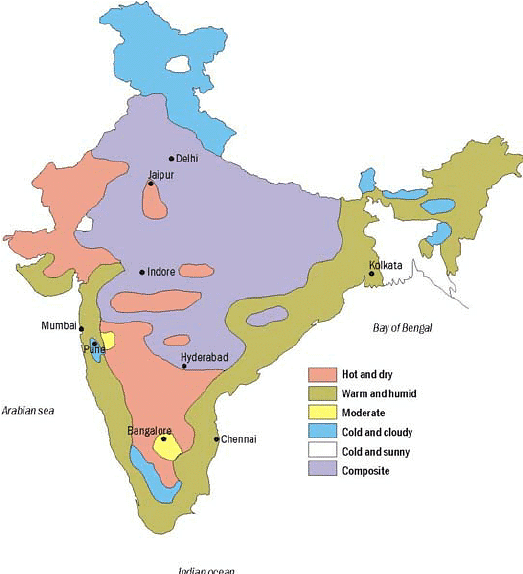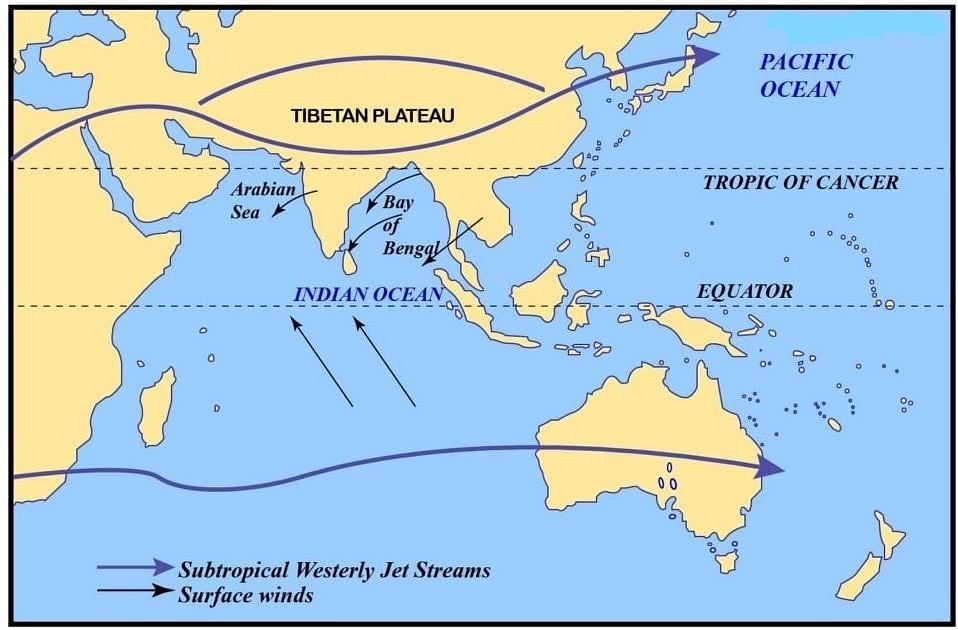Class 9 Geography Chapter 4 Notes - Climate
| Table of contents |

|
| Introduction |

|
| Climatic Controls |

|
| Factors Affecting India’s Climate |

|
| The Cold Weather Season (Winter) |

|
| The Hot Weather Season (Summer) |

|
Understanding Climate and Weather
We study climate to comprehend the atmospheric conditions that exist in our country. Climate refers to the overall pattern of weather conditions and changes across a vast area over a long time (more than thirty years). 
In contrast, weather describes the state of the atmosphere at a specific time and place. By examining the climate of India, we can answer questions like why we wear woollens in December, why it is hot and uncomfortable in May, and why it rains in June and July.
Elements of Weather and Climate
- The elements of weather and climate include temperature, atmospheric pressure, wind, humidity, and precipitation.
- Weather conditions can change frequently, even during a single day.
- However, there are typical patterns over weeks or months, such as:
- Cool or hot days
- Windy or calm conditions
- Wet or dry spells
- Based on these general monthly atmospheric conditions, the year is divided into seasons like winter, summer, and the rainy season.
By studying climate, we can enhance our understanding and predictions of weather patterns. The answers to all these questions can be found by looking at the climate of India.
Introduction
What is the Difference between Weather and Climate?
Weather refers to the state of the atmosphere in a specific area at any given moment. It can change quickly and varies from one moment to the next.
For example, it can be cloudy, dry, windy, or wet.
On the other hand, climate is the average of weather conditions over a large area for a long time, typically more than thirty years.
The factors that define both weather and climate include temperature, atmospheric pressure, wind, humidity, and precipitation.
 Climate and Weather Differences India has Diverse Climatic Conditions
Climate and Weather Differences India has Diverse Climatic Conditions
The year is divided into seasons such as winter, summer, and rainy season based on general monthly atmospheric conditions. We can look at how temperature and precipitation differ from one place to another and from season to season.
Temperature variations:
- Rajasthan desert: up to 50°C in summer
- Pahalgam, Jammu and Kashmir: around 20°C in summer
- Drass, Jammu and Kashmir: as low as -45°C in winter
- Thiruvananthapuram: around 22°C in winter
- Thar Desert: 50°C during the day, 15°C at night
- In contrast, there is hardly any difference in day and night temperatures in the Andaman and Nicobar Islands or in Kerala.
 Different Climatic Zones in India
Different Climatic Zones in India
Precipitation variations:
- Snowfall in the upper parts of the Himalayas
- Rainfall in the rest of the country
- Annual precipitation: over 400 cm in Meghalaya, less than 10 cm in Ladakh and western Rajasthan
- Rainy season: June to September for most areas, October and November for the Tamil Nadu coast
The term monsoon comes from the Arabic word ‘mausim,’ meaning season. Monsoon indicates the seasonal change in wind direction throughout the year. The climate in India is known as the 'monsoon' type, marked by considerable seasonal rainfall.
Although there is a general consistency in the climate across India, there are noticeable regional differences in climatic conditions throughout the country.
Climatic Controls
The climate of a location is shaped by several factors that work together to define its features. Climate is the overall pattern of weather conditions over a large area and a long period (more than thirty years). In contrast, weather describes the state of the atmosphere at a specific time and place.
The components of weather and climate are identical and include temperature, atmospheric pressure, wind, humidity, and precipitation. The key factors influencing climate include:
- Latitude: The curvature of the Earth affects how much solar energy different areas receive, leading to temperature differences from the equator to the poles. Locations nearer the equator are generally warmer.
 Latitudes
Latitudes - Altitude: At higher altitudes, the atmosphere is less dense, resulting in cooler temperatures. As you go higher, the air becomes thinner, which causes a drop in temperature. Therefore, hills are cooler in summer.
- Pressure and Wind Systems: The way pressure and wind are distributed around the Earth affects temperature and rainfall patterns, influenced by both latitude and altitude.
- Distance from the Sea (Continentality): Areas close to the sea often have milder climates because of the ocean's moderating effect. Locations further from the sea may experience more extreme weather with greater temperature changes.
- Ocean Currents: These currents significantly influence coastal climates, especially when combined with winds coming from the sea. Warm ocean currents can create milder temperatures, while cold currents may lead to cooler conditions.
- Relief Features: The presence of mountains and other relief features can have a significant impact on local climates. High mountains can block winds, causing them to rise and cool, which can increase rainfall on the side facing the wind. The opposite side, sheltered from the wind, is usually drier.
These factors combine to shape a region's climate, each contributing uniquely to the temperature, rainfall patterns, and general weather conditions experienced in that area. Additionally, the year is typically divided into seasons based on general monthly weather patterns, further affecting the climate in various regions.
Factors Affecting India’s Climate

Latitude
- The Tropic of Cancer runs through the middle of India, dividing it into tropical and subtropical regions.
- India is situated roughly between 8οN and 37ο N latitudes.
- India is divided into almost two equal parts by the tropic of cancer.
- The southern half lies in the tropical zone, and the western half is in the subtropical zone.
- Therefore, India’s climate has characteristics of tropical as well as subtropical climates.
Altitude
- India has mountains to the north, with an average height of about 6000 meters.
- The Himalayas prevent the cold winds from Central Asia from entering the subcontinent.
- It is because of these mountains that this subcontinent experiences comparatively milder winters than Central Asia.
Pressure and Winds
- The climate of India is affected by atmospheric conditions such as pressure, surface winds, upper air circulation, and cyclonic disturbances. It lies in the path of north-easterly winds from the subtropical high-pressure belt in the north.
- During winter, monsoon winds originate from a high-pressure zone north of the Himalayas and move towards low-pressure areas over the oceans to the south.
- In summer, a low-pressure area forms over interior Asia and northwestern India, reversing wind direction and bringing moist air from the southern Indian Ocean.
- The Southwest Monsoon winds carry moisture over warm oceans, resulting in heavy rainfall across mainland India.
The Seasons
- Cold weather season: December to February
- Hot weather season: March to May
- Advancing monsoon season: June to September
- Retreating monsoon season: October and November

The Cold Weather Season (Winter)
- The cold weather season in northern India lasts from mid-November to February, with December and January being the coldest months.
- Temperatures drop from south to north in India. For example, Chennai on the eastern coast has an average temperature of 24-25°C, while the northern plains see temperatures between 10°C and 15°C. Days tend to be warm, but nights get quite cold during this season.

- Frost is common in the north, and the higher Himalayan slopes see snowfall.
- During this time, the northeast trade winds dominate the country, blowing from land to sea, leading to a mostly dry season. However, some rainfall occurs on the Tamil Nadu coast as these winds blow from sea to land.
- In northern India, there is a slight variation in rainfall patterns during winter.
- A notable aspect of the cold weather season in the northern plains is the arrival of cyclonic disturbances from the west and northwest. These low-pressure systems come from the Mediterranean Sea and western Asia, moving into India and bringing essential winter rains to the plains and snowfall to the mountains.
- Though the total winter rainfall, locally called 'mahawat', is small, it is very important for the growth of 'rabi' crops.
- The peninsular region does not experience a distinct cold season, as there is hardly any noticeable change in temperature during winter due to the influence of the sea.
The Hot Weather Season (Summer)
- During summer in India, the sun shifts northward, which causes the global heat belt to move as well.
- From March to May, hot weather prevails in India due to this northward movement.
- In March, the highest temperature reaches around 38°C on the Deccan plateau.
- April temperatures can go up to 42°C in places like Gujarat and Madhya Pradesh.
- By May, temperatures often hit 45°C in the northwestern regions of the country.
- In peninsular India, temperatures are generally lower because of the cooling effect of the oceans.
 Atmospheric Conditions over the Indian Subcontinent in the Month of June
Atmospheric Conditions over the Indian Subcontinent in the Month of June
Weather Patterns
- During summer, northern India sees rising temperatures and decreasing air pressure.
- By the end of May, a low-pressure area extends from the Thar Desert in the northwest to Patna and the Chotanagpur plateau in the east and southeast.
- This leads to air circulation around the trough.
The 'Loo' Winds
- A notable aspect of this season is the 'loo', which are hot, dry winds that blow strongly during the day in northern and northwestern India.
- These winds can persist until late evening, and exposure to them can be dangerous.
- Dust storms are typical in northern India during May, providing brief relief by lowering temperatures and potentially bringing light rain and cool breezes.
- Localized thunderstorms often occur, featuring strong winds and heavy rain, sometimes with hail.
- In West Bengal, such storms are referred to as 'Kaal Baisakhi'.
Pre-Monsoon Showers
- As summer comes to an end, pre-monsoon showers become common, particularly in Kerala and Karnataka.
|
53 videos|437 docs|80 tests
|
FAQs on Class 9 Geography Chapter 4 Notes - Climate
| 1. What are the main factors affecting India's climate ? |  |
| 2. How does the cold weather season (winter) affect India’s climate ? |  |
| 3. What are the characteristics of the hot weather season (summer) in India ? |  |
| 4. How do monsoons influence India's climate ? |  |
| 5. What role do the Himalayas play in shaping India’s climate ? |  |





















